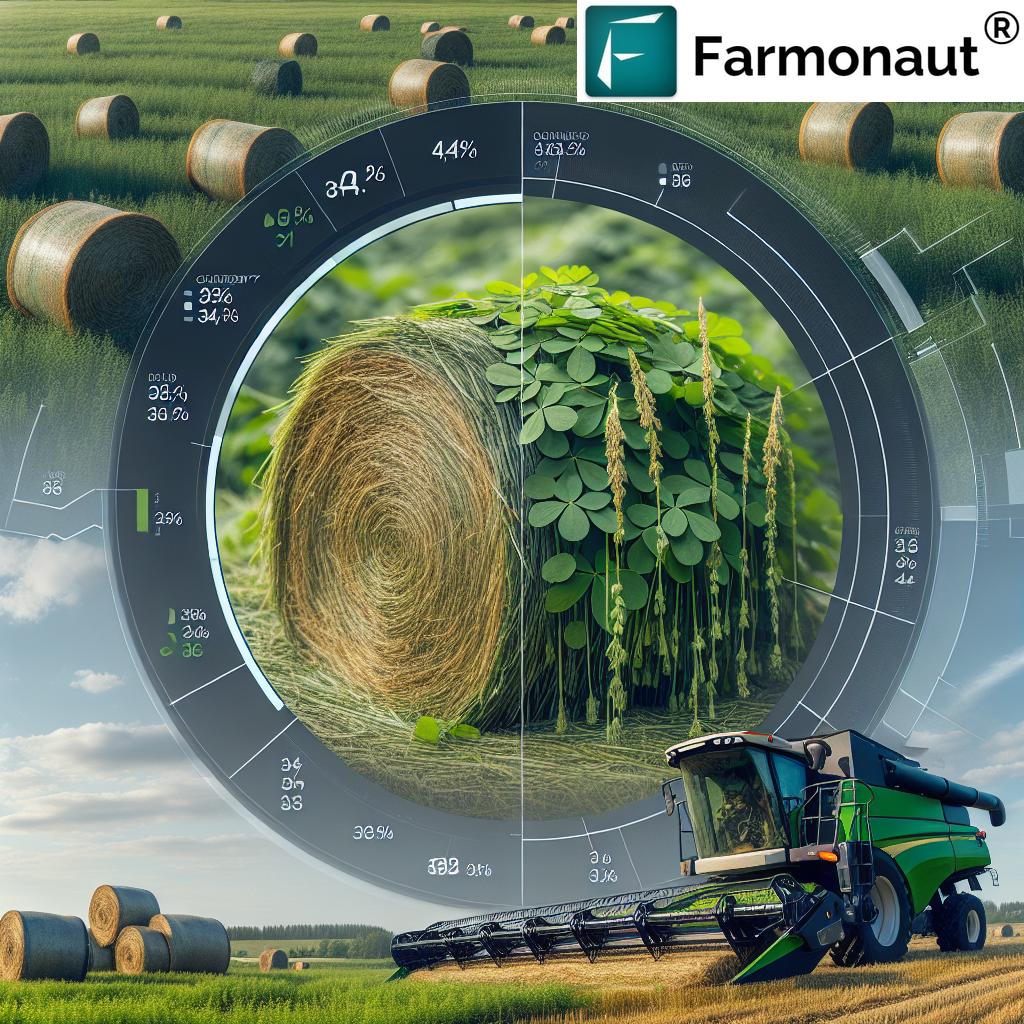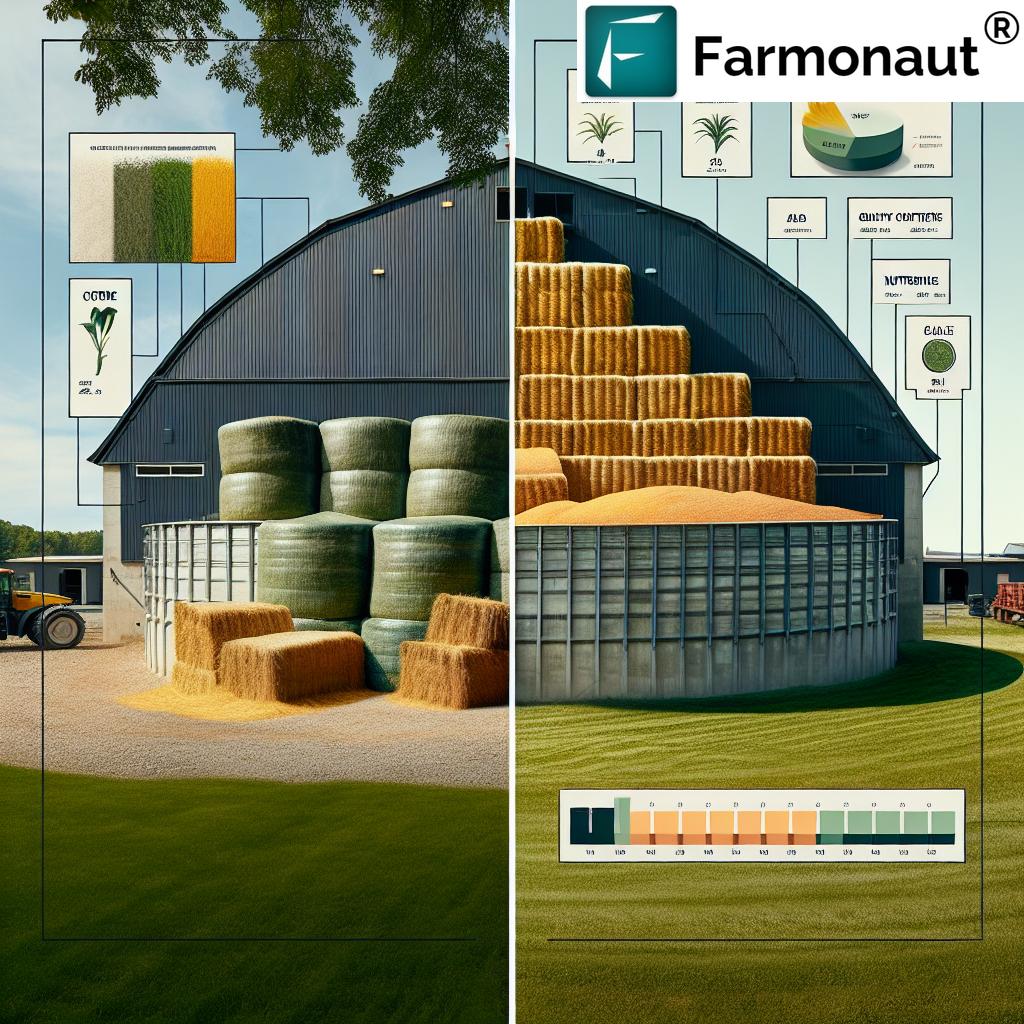USDA Hay Market Update: Analyzing March 2021 Prices and Quality Grades for Fort Atkinson, WI Farmers
“The USDA categorizes hay quality into four grades: Supreme, Premium, Good, and Fair, impacting market prices significantly.”
Welcome to our comprehensive analysis of the USDA hay market update for March 2021, focusing on prices and quality grades relevant to farmers in Fort Atkinson, Wisconsin. As we delve into this essential topic, we’ll explore the intricate factors that influence hay prices, quality assessments, and market trends. Our goal is to provide you with valuable insights that will help you make informed decisions for your agricultural operations.

Understanding USDA Hay Quality Grades
Before we dive into the specifics of the March 2021 market update, it’s crucial to understand the USDA hay quality grades. These grades play a significant role in determining market prices and are essential for both buyers and sellers in the forage industry.
- Supreme: The highest quality grade, characterized by very early maturity, fine-stemmed, and highly digestible.
- Premium: Early maturity, leafy, and fine-stemmed, with very good digestibility.
- Good: Early to average maturity, leafy, fine to medium-stemmed, with good digestibility.
- Fair: Late maturity, moderate leaf content, generally coarse-stemmed, with lower digestibility.
These grades are determined based on various factors, including maturity, leaf content, stem thickness, and overall nutritive value. Understanding these grades is crucial for farmers and buyers alike, as they directly impact pricing and animal nutrition.
March 2021 Hay Market Prices for Fort Atkinson, WI
Now, let’s examine the hay market prices for Fort Atkinson, Wisconsin, in March 2021. We’ll break down the prices by hay type and quality grade to give you a comprehensive overview of the market situation.
| Hay Type | Quality Grade | Price Range ($/ton) | Relative Feed Value (RFV) | Crude Protein (%) | Bale Type |
|---|---|---|---|---|---|
| Alfalfa | Supreme | 220-240 | 185+ | 22-24 | Small Square |
| Alfalfa | Premium | 180-200 | 170-185 | 20-22 | Large Round |
| Grass | Good | 140-160 | 100-130 | 10-12 | Large Round |
| Mixed (Alfalfa/Grass) | Premium | 160-180 | 140-160 | 16-18 | Small Square |
As we can see from the table, prices vary significantly based on hay type, quality grade, and bale size. Supreme quality alfalfa commands the highest prices, while grass hay and mixed hay fall into lower price ranges. These price differences reflect the nutritional value and desirability of each hay type for different livestock feeding purposes.
Factors Influencing Hay Prices and Quality
Several factors contribute to the variations in hay prices and quality. Let’s explore some of the key elements that farmers and buyers should consider:
- Maturity at Harvest: The stage of maturity at which hay is harvested significantly impacts its nutritional value. Early-cut hay typically has higher protein content and digestibility.
- Leaf Content: A higher leaf-to-stem ratio generally indicates better quality hay, as leaves contain more nutrients than stems.
- Weather Conditions: Rainfall, temperature, and sunlight during the growing season affect hay quality and yield.
- Soil Fertility: Proper nutrient management practices contribute to better hay quality and yields.
- Harvesting and Storage Methods: Proper harvesting techniques and storage practices help preserve hay quality.
Understanding these factors can help farmers optimize their hay production and make informed decisions about buying or selling hay in the market.
Importance of Forage Quality Indicators
When assessing hay quality, several key indicators provide valuable information about its nutritional content and potential value for livestock:
- Relative Feed Value (RFV): A measure of digestibility and potential intake, with higher values indicating better quality.
- Crude Protein (CP): Indicates the protein content of the hay, crucial for animal growth and milk production.
- Acid Detergent Fiber (ADF): Relates to the digestibility of the hay, with lower values being more desirable.
- Neutral Detergent Fiber (NDF): Indicates the total fiber content, which affects intake potential.
These indicators help both buyers and sellers determine the true value of hay beyond its visual appearance.
Hay Bale Size Comparison and Its Impact on Pricing
The size and type of hay bales can significantly affect pricing and handling. Let’s compare the most common bale types:
- Small Square Bales: Typically weigh 40-70 pounds, easy to handle manually, often preferred for small-scale operations or horse owners.
- Large Square Bales: Can weigh 500-2000 pounds, require machinery for handling, efficient for large-scale operations and long-distance transport.
- Large Round Bales: Usually weigh 800-1500 pounds, suitable for outdoor storage, commonly used in beef cattle operations.
Bale size affects not only handling and storage but also pricing. Smaller bales often command a premium price per ton due to increased labor costs, while large bales may be more economical for bulk purchases.
“Factors like maturity, leaf content, and bale size can cause hay prices to vary across different states.”
Hay Storage Best Practices
Proper storage is crucial for maintaining hay quality over time. Here are some best practices for hay storage:
- Store hay in a dry, covered area to protect it from moisture and sunlight.
- Elevate bales off the ground to prevent moisture absorption.
- Ensure proper ventilation to prevent mold growth.
- Stack bales correctly to maintain shape and allow air circulation.
- Consider using preservatives for hay baled at higher moisture levels.
Implementing these storage practices can help preserve the nutritional value of hay and reduce losses due to spoilage.
Silage Production Techniques
While our focus has been on dry hay, it’s worth discussing silage production as an alternative forage preservation method. Silage offers several advantages, including:
- Less weather dependency during harvest
- Potential for higher nutrient retention
- Reduced storage losses compared to dry hay
Key considerations for successful silage production include:
- Proper moisture content at harvest (typically 60-70% for corn silage)
- Rapid filling and sealing of the silo or bunker
- Adequate compaction to remove oxygen
- Use of inoculants to promote fermentation
Silage can be an excellent complement to hay in a comprehensive forage management strategy.

Nutrient Management in Forage Production
Effective nutrient management is crucial for producing high-quality forage and maintaining soil health. Consider the following strategies:
- Regular soil testing to determine nutrient needs
- Proper timing of fertilizer applications
- Use of legumes (like alfalfa) to fix nitrogen
- Rotational grazing to distribute nutrients naturally
- Monitoring of plant tissue nutrient levels
By implementing a comprehensive nutrient management plan, farmers can optimize forage yield and quality while minimizing environmental impact.
Market Trends and Future Outlook
As we analyze the March 2021 hay market update for Fort Atkinson, WI, it’s important to consider broader market trends and future outlook. Some key factors to watch include:
- Weather patterns and their impact on hay production
- Changes in livestock populations and feed demand
- Shifts in cropping patterns that may affect hay acreage
- Developments in transportation costs and logistics
- Potential impacts of climate change on forage production
Staying informed about these trends can help farmers and buyers make strategic decisions in the hay market.
Leveraging Technology in Forage Management
In today’s digital age, technology plays an increasingly important role in forage management. Farmers can benefit from various tools and platforms to optimize their operations. One such innovative solution is Farmonaut, a satellite-based farm management platform that offers valuable insights for crop monitoring and decision-making.
Farmonaut’s satellite-based crop monitoring system can help forage producers:
- Track crop health and growth patterns
- Identify potential issues early, such as pest infestations or nutrient deficiencies
- Optimize irrigation and resource management
- Make data-driven decisions for harvesting and field management
By integrating such technologies into their operations, farmers can enhance productivity and make more informed decisions in the dynamic hay and forage market.
Explore Farmonaut’s solutions:
Conclusion
The March 2021 USDA hay market update for Fort Atkinson, WI, provides valuable insights into current pricing trends and quality assessments. By understanding the factors that influence hay quality and market dynamics, farmers and buyers can make more informed decisions. Remember to consider factors such as maturity, leaf content, and bale size when evaluating hay prices and quality.
As the agricultural industry continues to evolve, staying informed about market trends, implementing best practices in hay production and storage, and leveraging technologies like Farmonaut can help farmers optimize their operations and succeed in the competitive forage market.
FAQ Section
Q: How often does the USDA release hay market updates?
A: The USDA typically releases hay market updates on a weekly or bi-weekly basis, depending on the region and market activity.
Q: What factors most significantly impact hay prices?
A: The most significant factors include hay quality (grade), type (alfalfa, grass, mixed), weather conditions, regional supply and demand, and transportation costs.
Q: How can I determine the quality of my hay?
A: You can determine hay quality through visual assessment, but for accurate results, it’s best to have your hay tested by a certified laboratory for nutritional content and RFV.
Q: Is it better to sell hay as small square bales or large round bales?
A: The best option depends on your target market. Small square bales often fetch higher prices per ton but require more labor. Large round bales are more efficient for bulk sales and larger operations.
Q: How can technology like Farmonaut help in forage production?
A: Farmonaut’s satellite-based monitoring can help optimize crop management by providing real-time insights on crop health, allowing for timely interventions and more efficient resource utilization.
By staying informed about market trends, implementing best practices, and leveraging innovative technologies like Farmonaut, farmers can optimize their forage production and navigate the dynamic hay market successfully. Remember to regularly check USDA updates and consider factors like quality grades, bale sizes, and storage methods when making decisions about buying or selling hay.
For more information on satellite-based crop monitoring and how it can benefit your forage production, visit Farmonaut’s API or explore their API Developer Docs.






